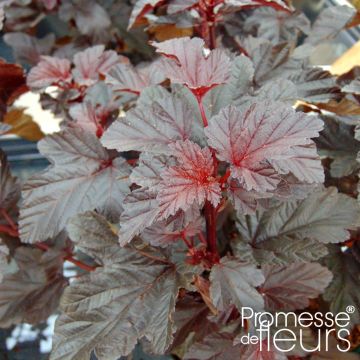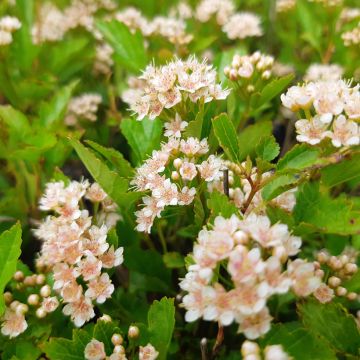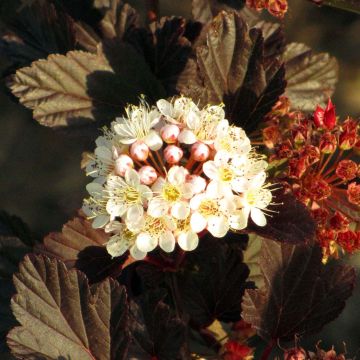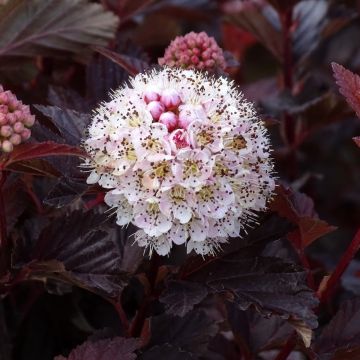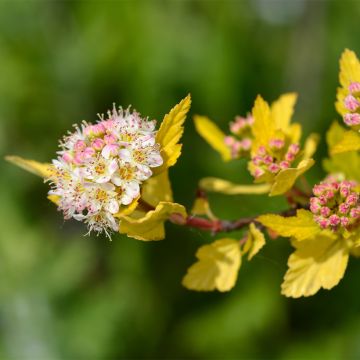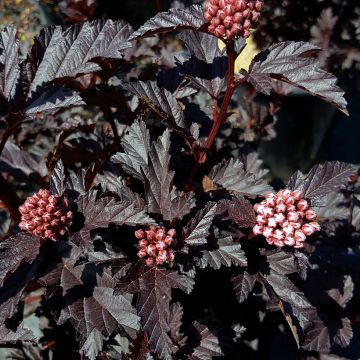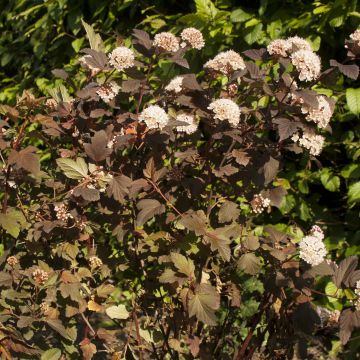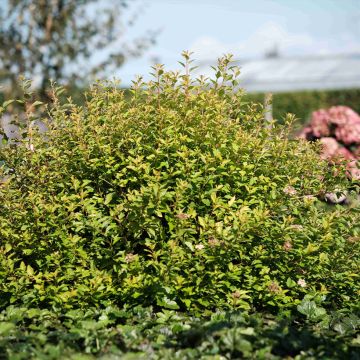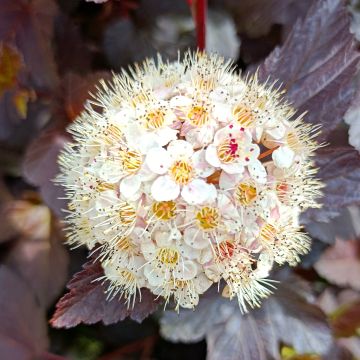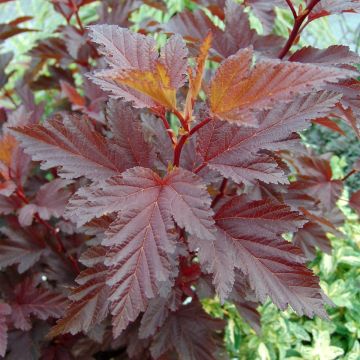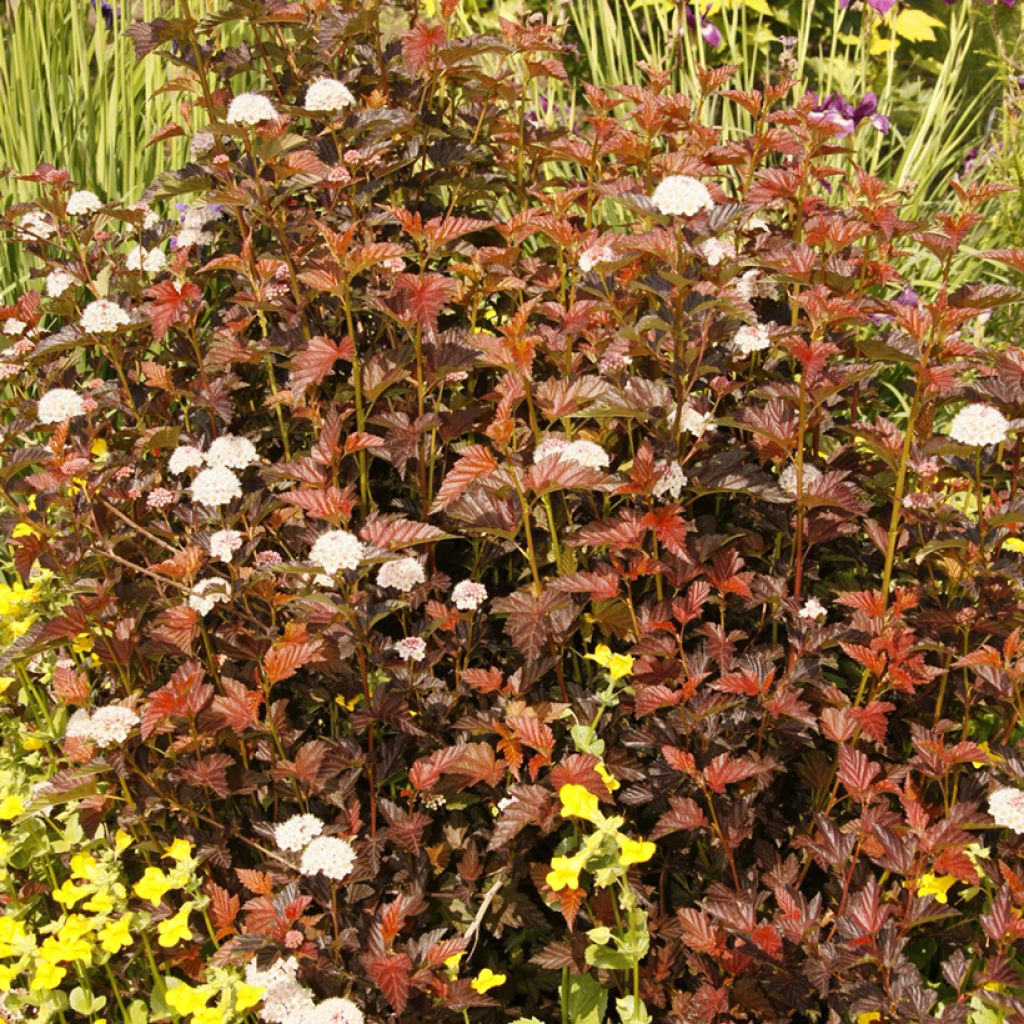

Physocarpus opulifolius Zdechovice - Ninebark
Physocarpus opulifolius Zdechovice - Ninebark
Physocarpus opulifolius Zdechovice
Ninebark, Eastern ninebark
This item cannot be shipped to the selected country
Delivery charge from €5.90
More information
Schedule delivery date,
and select date in basket
This plant carries a 24 months recovery warranty
More information
We guarantee the quality of our plants for a full growing cycle, and will replace at our expense any plant that fails to recover under normal climatic and planting conditions.
From €5.90 for pickup delivery and €6.90 for home delivery
Express home delivery from €8.90.
Does this plant fit my garden?
Set up your Plantfit profile →
Description
The Physocarpus opulifolius 'Zdechovice' is a variety of Physocarpus that forms a medium-sized bush with a balanced habit, featuring particularly ornamental foliage from spring to autumn. Its leaves emerge in shades of orange-red before turning to a purple mixed with changing tones depending on the season. In late spring, its flowering in pinkish-white corymbs is beautifully highlighted by the foliage. In autumn, the bush is adorned with small red fruits grouped in decorative clusters.
The Physocarpus belongs to the large family of Rosaceae. The wild species, Physocarpus opulifolius, is a deciduous plant that grows naturally in the eastern United States, from Quebec to Virginia. It is an arching bush that usually reaches a height of 1.50m to 3m. In winter, mature specimens have a brownish-brown bark that peels off, adding another ornamental feature to this species.
Physocarpus opulifolius 'Zdechovice' is a horticultural variety that grows relatively large, reaching approximately 2m in all directions. It has a fairly regular habit, naturally taking on a spherical shape, with dense and abundant vegetation. A multitude of fairly thin, stiff, and erect branches form a dense vegetal volume, the ball-like silhouette of which can be further refined by the action of shearing. The bush has pretty trilobed leaves, with a doubly dentate outline, well-marked veins, and a slightly glossy surface. The young leaves emerge in a harmony of yellow and orange with a touch of red, on reddish stems. They then gradually turn to a more or less purplish red that coexists with the predominantly orange young shoots. When autumn arrives, the foliage turns to a purplish-brown before falling.
This vegetal chameleon also offers a pleasant flowering that blooms in June and July in the form of corymbs measuring 5 to 8cm in diameter. Made up of small pinkish-white flowers, these clusters are well highlighted by the vegetation, creating a visually striking contrast. Although not fragrant, the flowers are visited by bees. From September, small bright red fruits form like small 5-branch stars clustered at the end of the stems. Small but numerous, these fruits have a real ornamental interest in autumn.
The Physocarpus opulifolius 'Zdechovice' is perfect for brightening up a varied shrub bed. It can also be planted in a free hedge. The Choisya 'Goldfinger', with its highly architectural palmate leaves of golden yellow, will be a good companion. It will also reward you with a highly fragrant white flowering in spring. The Photinia fraseri 'Pink Marble' has glossy evergreen foliage, dark green variegated with cream white, which is enhanced in spring by a beautiful pink veil. Another interesting variegated shrub that will go well with the Physocarpus is the Viburnum tinus 'Variegatum'. This Laurustinus is recognised for its leaves of a beautiful green with cream yellow margins. Add some shrubs with abundant flowering to complete your hedge, such as the Spiraea billardii with its large spikes of deep pink in summer, or the Amelanchier alnifolia 'Martin', a generous plant that will offer you a magnificent white spring flowering, followed by decorative and tasty fruits and beautiful autumn colours.
Report an error about the product description
Plant habit
Flowering
Foliage
Botanical data
Physocarpus
opulifolius
Zdechovice
Rosaceae
Ninebark, Eastern ninebark
Cultivar or hybrid
Other Physocarpus
Planting and care
Plant Physocarpus opulifolius 'Zdechovice' in deep, humus-bearing, rich and moist soil, acidic, neutral or even slightly alkaline, which it still fears in excess. Avoid letting the soil dry out excessively in summer and spray the foliage during heatwaves, especially in hot regions. This bush will thrive in partial shade or full sun, but avoid overly hot exposures. Thin out dense plants by pruning severely some of the arching stems after flowering. This can promote the emergence of new flower buds in late summer. Physocarpus tends to produce many suckers, to the detriment of the mother plant; it may be useful to prune it back to give it a denser appearance.
Planting period
Intended location
Care
This item has not been reviewed yet - be the first to leave a review about it.
Haven't found what you were looking for?
Hardiness is the lowest winter temperature a plant can endure without suffering serious damage or even dying. However, hardiness is affected by location (a sheltered area, such as a patio), protection (winter cover) and soil type (hardiness is improved by well-drained soil).

Photo Sharing Terms & Conditions
In order to encourage gardeners to interact and share their experiences, Promesse de fleurs offers various media enabling content to be uploaded onto its Site - in particular via the ‘Photo sharing’ module.
The User agrees to refrain from:
- Posting any content that is illegal, prejudicial, insulting, racist, inciteful to hatred, revisionist, contrary to public decency, that infringes on privacy or on the privacy rights of third parties, in particular the publicity rights of persons and goods, intellectual property rights, or the right to privacy.
- Submitting content on behalf of a third party;
- Impersonate the identity of a third party and/or publish any personal information about a third party;
In general, the User undertakes to refrain from any unethical behaviour.
All Content (in particular text, comments, files, images, photos, videos, creative works, etc.), which may be subject to property or intellectual property rights, image or other private rights, shall remain the property of the User, subject to the limited rights granted by the terms of the licence granted by Promesse de fleurs as stated below. Users are at liberty to publish or not to publish such Content on the Site, notably via the ‘Photo Sharing’ facility, and accept that this Content shall be made public and freely accessible, notably on the Internet.
Users further acknowledge, undertake to have ,and guarantee that they hold all necessary rights and permissions to publish such material on the Site, in particular with regard to the legislation in force pertaining to any privacy, property, intellectual property, image, or contractual rights, or rights of any other nature. By publishing such Content on the Site, Users acknowledge accepting full liability as publishers of the Content within the meaning of the law, and grant Promesse de fleurs, free of charge, an inclusive, worldwide licence for the said Content for the entire duration of its publication, including all reproduction, representation, up/downloading, displaying, performing, transmission, and storage rights.
Users also grant permission for their name to be linked to the Content and accept that this link may not always be made available.
By engaging in posting material, Users consent to their Content becoming automatically accessible on the Internet, in particular on other sites and/or blogs and/or web pages of the Promesse de fleurs site, including in particular social pages and the Promesse de fleurs catalogue.
Users may secure the removal of entrusted content free of charge by issuing a simple request via our contact form.
The flowering period indicated on our website applies to countries and regions located in USDA zone 8 (France, the United Kingdom, Ireland, the Netherlands, etc.)
It will vary according to where you live:
- In zones 9 to 10 (Italy, Spain, Greece, etc.), flowering will occur about 2 to 4 weeks earlier.
- In zones 6 to 7 (Germany, Poland, Slovenia, and lower mountainous regions), flowering will be delayed by 2 to 3 weeks.
- In zone 5 (Central Europe, Scandinavia), blooming will be delayed by 3 to 5 weeks.
In temperate climates, pruning of spring-flowering shrubs (forsythia, spireas, etc.) should be done just after flowering.
Pruning of summer-flowering shrubs (Indian Lilac, Perovskia, etc.) can be done in winter or spring.
In cold regions as well as with frost-sensitive plants, avoid pruning too early when severe frosts may still occur.
The planting period indicated on our website applies to countries and regions located in USDA zone 8 (France, United Kingdom, Ireland, Netherlands).
It will vary according to where you live:
- In Mediterranean zones (Marseille, Madrid, Milan, etc.), autumn and winter are the best planting periods.
- In continental zones (Strasbourg, Munich, Vienna, etc.), delay planting by 2 to 3 weeks in spring and bring it forward by 2 to 4 weeks in autumn.
- In mountainous regions (the Alps, Pyrenees, Carpathians, etc.), it is best to plant in late spring (May-June) or late summer (August-September).
The harvesting period indicated on our website applies to countries and regions in USDA zone 8 (France, England, Ireland, the Netherlands).
In colder areas (Scandinavia, Poland, Austria...) fruit and vegetable harvests are likely to be delayed by 3-4 weeks.
In warmer areas (Italy, Spain, Greece, etc.), harvesting will probably take place earlier, depending on weather conditions.
The sowing periods indicated on our website apply to countries and regions within USDA Zone 8 (France, UK, Ireland, Netherlands).
In colder areas (Scandinavia, Poland, Austria...), delay any outdoor sowing by 3-4 weeks, or sow under glass.
In warmer climes (Italy, Spain, Greece, etc.), bring outdoor sowing forward by a few weeks.

































